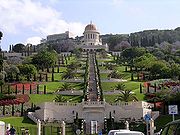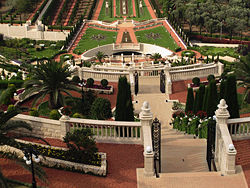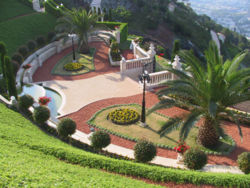
Terraces (Bahá'í)
Encyclopedia



Bahá'í Faith
The Bahá'í Faith is a monotheistic religion founded by Bahá'u'lláh in 19th-century Persia, emphasizing the spiritual unity of all humankind. There are an estimated five to six million Bahá'ís around the world in more than 200 countries and territories....
, also known as the Hanging Gardens of Haifa, are garden terraces around the Shrine of the Báb
Shrine of the Báb
The Shrine of the Báb is a structure in Haifa, Israel where the remains of the Báb, founder of Bábism and forerunner of Bahá'u'lláh in the Bahá'í Faith, have been laid to rest; it is considered to be the second holiest place on Earth for Bahá'ís, after the Shrine of Bahá'u'lláh in Acre...
on Mount Carmel in Haifa
Haifa
Haifa is the largest city in northern Israel, and the third-largest city in the country, with a population of over 268,000. Another 300,000 people live in towns directly adjacent to the city including the cities of the Krayot, as well as, Tirat Carmel, Daliyat al-Karmel and Nesher...
, Israel
Israel
The State of Israel is a parliamentary republic located in the Middle East, along the eastern shore of the Mediterranean Sea...
. They are one of the most visited tourist attractions in Israel
Israel
The State of Israel is a parliamentary republic located in the Middle East, along the eastern shore of the Mediterranean Sea...
. The architect is Fariborz Sahba
Fariborz Sahba
Fariborz Sahba is an Iranian Bahá'í architect, now living in Canada.-Career:He has a Masters degree from Faculty of Fine Arts at the University of Tehran...
from Iran
Iran
Iran , officially the Islamic Republic of Iran , is a country in Southern and Western Asia. The name "Iran" has been in use natively since the Sassanian era and came into use internationally in 1935, before which the country was known to the Western world as Persia...
. Along with the Baha'i Holy Places
Bahá'í World Centre buildings
The Bahá'í World Centre buildings are buildings that are part of the Bahá'í World Centre in Israel. The Bahá'í World Centre buildings include both the Bahá'í holy places used for pilgrimage and the international administrative bodies of the Bahá'í Faith; they comprise more than 20 different...
in Western Galilee
Galilee
Galilee , is a large region in northern Israel which overlaps with much of the administrative North District of the country. Traditionally divided into Upper Galilee , Lower Galilee , and Western Galilee , extending from Dan to the north, at the base of Mount Hermon, along Mount Lebanon to the...
, it is a UNESCO
UNESCO
The United Nations Educational, Scientific and Cultural Organization is a specialized agency of the United Nations...
World Heritage Site
World Heritage Site
A UNESCO World Heritage Site is a place that is listed by the UNESCO as of special cultural or physical significance...
.
Symbolism
The terraces represent the first eighteen disciples of the BábBáb
Siyyid `Alí Muḥammad Shírází was the founder of Bábism, and one of three central figures of the Bahá'í Faith. He was a merchant from Shíráz, Persia, who at the age of twenty-four claimed to be the promised Qá'im . After his declaration he took the title of Báb meaning "Gate"...
, who were designated "Letter of the Living
Letters of the Living
The Letters of the Living was a title provided by the Báb to the first eighteen disciples of the Bábí Religion. In some understandings the Báb places himself at the head of this list...
", although no individual terraces are connected with individual Letters.
Design
Nine concentric circles provide the main geometry of the eighteen terraces. Just as the identification of a circle presupposes a centre, so the terraces have been conceived as generated from the Shrine of the Báb. The eighteen terraces plus the one terrace of the Shrine of the Báb make nineteen terraces total. Nineteen19 (number)
19 is the natural number following 18 and preceding 20. It is a prime number.In English speech, the numbers 19 and 90 are often confused. When carefully enunciated, they differ in which syllable is stressed: 19 vs 90...
is a significant number within both the Bahá'í and Bábí religions.
Fariborz Sahba began work in 1987 designing the gardens and oversaw construction. Beginning at its base, the gardens extend almost a kilometre up the side of Mount Carmel, covering some 200,000 square metres of land. The gardens are linked by a set of stairs flanked by twin streams of running water cascading down the mountainside through the steps and terrace bridges.
The gardens have elements of the Persian paradise garden
Paradise garden
The Paradise garden is a form of garden, originally just paradise, a word derived from the Median language, or Old Persian. Its original meaning was "a walled-in compound or garden"; from pairi and daeza or diz...
s, isolating the site from the noise of the surroundings and connecting the different Bahá'í buildings
Bahá'í World Centre buildings
The Bahá'í World Centre buildings are buildings that are part of the Bahá'í World Centre in Israel. The Bahá'í World Centre buildings include both the Bahá'í holy places used for pilgrimage and the international administrative bodies of the Bahá'í Faith; they comprise more than 20 different...
on Mount Carmel together.

